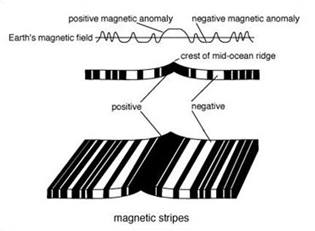Mid-Atlantic Ridge
The North American and Eurasian Plates are moving away from each other along the line of the Mid Atlantic Ridge. The Ridge extends into the South Atlantic Ocean between the South American and African Plates. The ocean ridge rises to between 2 to 3 km above the ocean floor, and has a rift valley at its crest marking the location at which the two plates are moving apart.
The Mid Atlantic Ridge, like other ocean ridge systems, has developed as a consequence of the divergent motion between the Eurasian and North American, and African and South American Plates. As the mantle rises towards the surface below the ridge the pressure is lowered (decompression) and the hot rock starts to partially melt. This produces basaltic volcanoes when an eruption occurs above the surface (Eyjafjallajökull in Iceland) and characteristic basalt “pillow lava” in underwater eruptions. In this way, as the plates move further apart new ocean lithosphere is formed at the ridge and the ocean basin gets wider. This process is known as “sea floor spreading” and results in a symmetrical alignment of the rocks of the ocean floor which get older with distance from the ridge crest.
Loading the player ...
Evidence for this process comes from the magnetic properties of the erupted basalt. The Earth’s magnetic field has been shown to “flip” occasionally so that the North and South magnetic poles reverse with time. Basalt contains minute magnetic minerals that take on the direction of the Earth’s magnetic field at the time of eruption.
Image courtesy of the Naked Science Society

Magnetic stripes on the ocean floor
These polarity reversals are therefore recorded in the rocks forming at the Mid Atlantic Ridge every time the Earth’s magnetism changes from a normal field (as it is today) to a reversed field (as it was about 0.78 million years ago). When these variations in the magnetic rocks are mapped on the ocean bed they are seen to line up in a series of alternating “magnetic stripes”, rather like barcodes.
The significance of the magnetic stripes was only revealed when their ages were discovered from dating magnetic reversals in volcanic rocks accessible on land. The dates revealed that the Atlantic Ocean was opening by seafloor spreading from the Mid Atlantic Ridge at a rate of about 0.02 metres per year.
This means that North America and Europe are moving away from each other at about the rate it takes for your fingernails to grow.